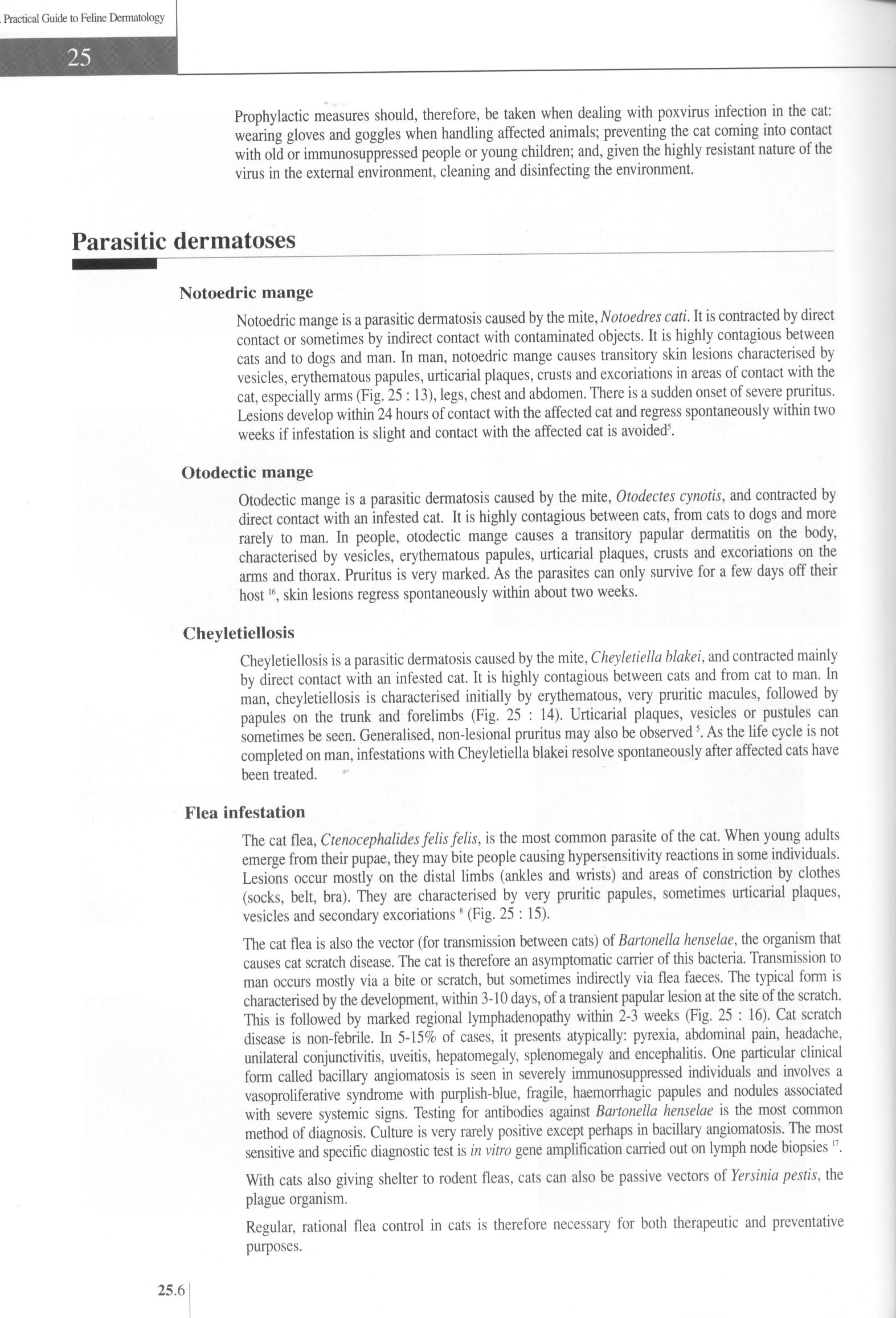256 (18)

25
, Practical Guide to Feline Dermatology
Prophylactic measures should, therefore, be taken when dealing with poxvirus infection in the cat: wearing gloves and goggles when handling affected animals; preventing the cat coming into contact with old or immunosuppressed people or young children; and, given the highly resistant naturę of the virus in the extemal environment, cleaning and disinfecting the environment.
Parasitic dermatoses
Notoedric mange
Notoedric mange is a parasitic dermatosis caused by the mite, Notoedres cati. It is contracted by direct contact or sometimes by indirect contact with contaminated objects. It is highly contagious between cats and to dogs and man. In man, notoedric mange causes transitory skin lesions characterised by vesicles, erythematous papules, urticarial plaąues, crusts and excoriations in areas of contact with the cat, especially arms (Fig. 25 :13), legs, chest and abdomen. There is a sudden onset of severe pruritus. Lesions develop within 24 hours of contact with the affected cat and regress spontaneously within two weeks if infestation is slight and contact with the affected cat is avoided5.
Otodectic mange
Otodectic mange is a parasitic dermatosis caused by the mite, Otodectes cynotis, and contracted by direct contact with an infested cat. It is highly contagious between cats, from cats to dogs and morę rarely to man. In people, otodectic mange causes a transitory papular dermatitis on the body, characterised by vesicles, erythematous papules, urticarial plaąues, crusts and excoriations on the arms and thorax. Pruritus is very marked. As the parasites can only survive for a few days off their hostl6, skin lesions regress spontaneously within about two weeks.
Cheyletiellosis
Cheyletiellosis is a parasitic dermatosis caused by the mite, Cheyletiella blakei, and contracted mainly by direct contact with an infested cat. It is highly contagious between cats and from cat to man. In man, cheyletiellosis is characterised initially by erythematous, very pruritic macules, followed by papules on the trunk and forelimbs (Fig. 25 : 14). Urticarial plaąues, vesicles or pustules can sometimes be seen. Generalised, non-lesional pruritus may also be observed5. As the life cycle is not completed on man, infestations with Cheyletiella blakei resolve spontaneously after affected cats have been treated.
Flea infestation
The cat flea, Ctenocephalides felis felis, is the most common parasite of the cat. When young adults emerge from their pupae, they may bite people causing hypersensitivity reactions in some individuals. Lesions occur mostly on the distal limbs (ankles and wrists) and areas of constriction by clothes (socks, belt, bra). They are characterised by very pruritic papules, sometimes urticarial plaąues, vesicles and secondary excoriations8 (Fig. 25 : 15).
The cat flea is also the vector (for transmission between cats) of Bartonella henselae, the organism that causes cat scratch disease. The cat is therefore an asymptomatic carrier of this bacteria. Transmission to man occurs mostly via a bite or scratch, but sometimes indirectly via flea faeces. The typical form is characterised by the development, within 3-10 days, of a transient papular lesion at the site of the scratch. This is followed by marked regional lymphadenopathy within 2-3 weeks (Fig. 25 : 16). Cat scratch disease is non-febrile. In 5-15% of cases, it presents atypically: pyrexia, abdominal pain, headache, unilateral conjunctivitis, uveitis, hepatomegaly, splenomegaly and encephalitis. One particular clinical form called bacillary angiomatosis is seen in severely immunosuppressed individuals and involves a vasoproliferative syndrome with purplish-blue, fragile, haemorrhagic papules and nodules associated with severe systemie signs. Testing for antibodies against Bartonella henselae is the most common method of diagnosis. Culture is very rarely positive except perhaps in bacillary angiomatosis. The most sensitive and specific diagnostic test is in vitro gene amplification carried out on lymph node biopsiesl7.
With cats also giving shelter to rodent fleas, cats can also be passive vectors of Yersinia pestis, the plague organism.
Regular, rational flea control in cats is therefore necessary for both therapeutic and preventative purposes.
25.6
Wyszukiwarka
Podobne podstrony:
252 (18) 25 A Practical Guide to Feline DermatologySporotrichosis Sporotrichosis is a deep mycosis,
254 (18) 25 A Practical Guide to Feline Dermatology 25 A Practical Guide to Feline DermatologyBacter
274 (18) 27 A Practical Guide to Feline Dermatology Colitis 11.2 Collagen 1.2,2.6,12.1,
58 (148) 5 A Practical Guide to Feline Dermatology severity of the illness. High titres are seen wit
278 (17) 27 A Practical Guide to Feline Dermatology I J Histoplasmosis 5.8, 7.8, 25.2 Homer’s syndro
65 (127) 6 A Practical Guide to Feline Dermatology Other topical antimicrobial agents, such as chlor
67 (125) 6 A Practical Guide to Feline DermatologyNocardiosisAetiopathogenesis Nocardiosis is a very
69 (119) 6 A Practical Guide to Feline DermatologyDiagnosis The diagnosis is based on lesion distrib
710 (2) 7 A Practical Guide to Feline DermatologyHerpesvirus infections Dermatological manifestation
74 (105) 7 A Practical Guide to Feline Dermatology ulcerated. Lesion distribution is multicentric bu
27 A Practical Guide to Feline Dermatology Perianal glands 1.7 Permethrin 3.12, 3.13 Persian 1.6,2.2
27 A Practical Guide to Feline Dermatology Stemphyllium spp. 5.1,7.8 Stereotypie behaviour 17.1,
272 (16) 27 A Practical Guide to Feline Dermatology Alternaria spp. 5.1,7.8 Aluminium hyroxide 15.6&
28 (374) 2 A Practical Guide to Feline Dermatology Configuration of lesions Determining the configur
313 (14) A Practical Guide to Feline Dermatology The second phase consists of long-term control of t
31 (328) 3 A Practical Guide to Feline Dermatology Sarcoptic mange Sarcoptes scabiei var canis (Tabl
82 (128) 8 A Practical Guide to Feline Dermatology considered important parasites. Cats in the Unite
42 (226) 4 A Practical Guide to Feline Dermatology Increased hydration and subsequent maceration of
44 (228) 4 A Practical Guide to Feline Dermatolog) The term “asymptomatically infected cat” refers
więcej podobnych podstron